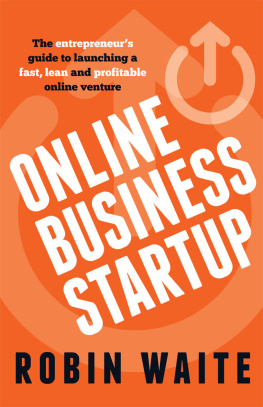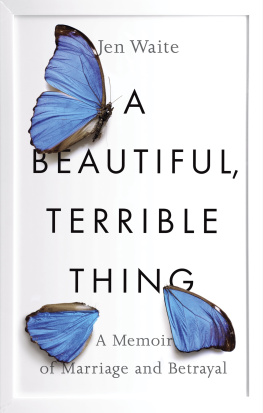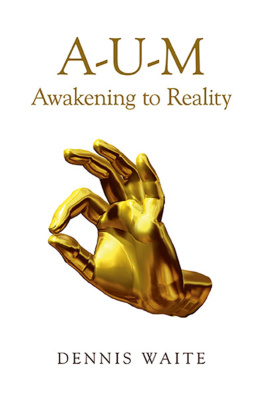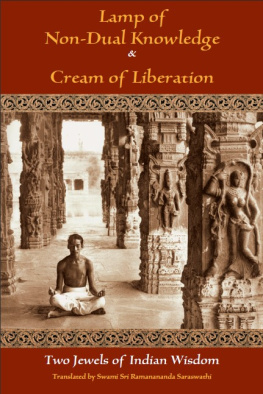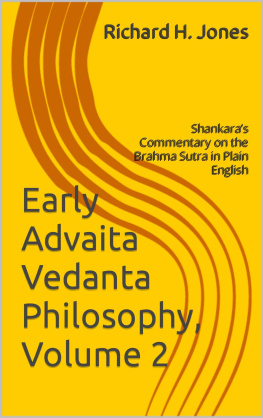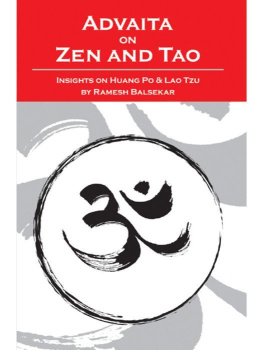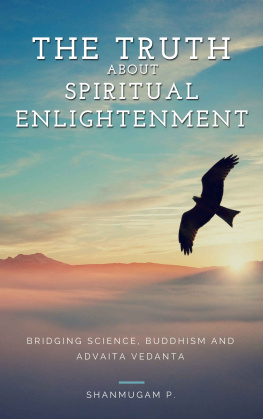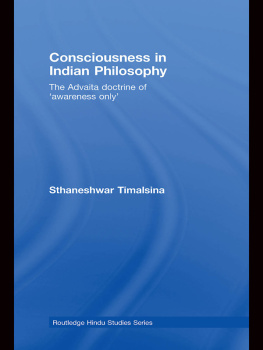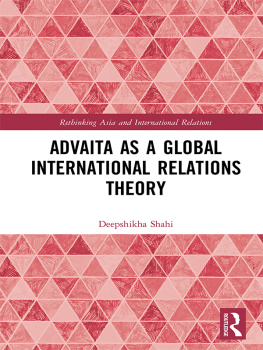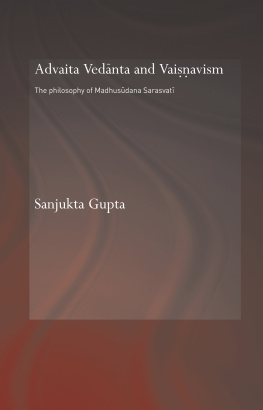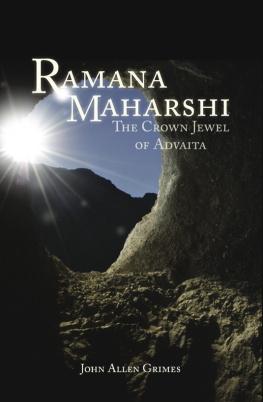ACKNOWLEDGEMENTS AND PERMISSIONS
T he author would like to thank the following for permission to reproduce material, endorsements and general assistance and support as indicated. Every care has been taken to trace copyright holders. If anyone has been omitted, sincere apologies are offered and corrections will be made to any future edition if the author or publisher is notified. The numbers in brackets after each acknowledgement reference the related publication in the Bibliography. The listing is in alphabetical order of surnames.
Acorn Press (129); Nicole Adams of The Infinity Institute for Compassionate Living (42, 66, 79, 155) for permission to use the extracts of her husband, Robert Adams (Dont forget the most important thing: Love, Compassion and Humility.); Sailor Bob Adamson (9); Advaita Ashrama (1, 12, 26, 27, 34, 35, 85, 88, 124, 191, 225, 227); The Advaita Fellowship (29, 60, 113, 133, 146, 164, 198, 235, 334); Adyashanti (208, 309); Monica Alderton (272) and for her encouragement and useful review comments); Swami Amaleshananda, Ramakrishna Math, Kalady (71); Prem Anjali, Integral Yoga Publications (11, 357); Atagrasin (307); Ramesh S. Balsekar (7, 60, 111, 145, 146, 164, 198); Manju Bazzell, The Gangagi Foundation (131); Bhaskar (325); James Braha (346) and for his kind endorsement; Sundance Burke (211); David Carse (313) and for his kind endorsement; Ram Chandran (161, 331) and for his kind endorsement; Cee (258); Chetana Pvt Ltd. (5, 7); University of Chicago Press (241); Central Chinmaya Mission Trust (6, 18, 33, 75, 81, 122, 156, 213, 230, 343); The Chiltern Yoga Trust (38); Anthony Collins, Shanti Sadan (24, 335); Robin Dale (374); Katie Davis (249) and for her kind endorsement; Tanya Davis (56); Swami Dayananda (31, 58, 90, 112, 186, 256, 264, 352, 363); Professor Eliot Deutsch (82); General Secretary, The Divine Life Society Headquarters (2, 23, 36, 67, 126, 138, 144, 214, 228, 245, 288, 373); Martha Doherty for obtaining permission from Swami Dayananda; Durga for help during the writing; Jenell Forschler, Shambhala Publications, Inc. (311); Carlo Frua, aurea vidyA Foundation (69, 182, 372); Nathan Gill (25, 338); David Godman (17, 243); Dr. Gregory Goode (53, 57, 226, 289, 355, 370) and for his critical reviews, extensive suggestions and endorsement; Ranva Grner, advaitaMedia (206); Burt Harding (147); Steven Harrison (210, 265); Dr. Harsh K. Luthar (310); Leo Hartong (22, 239, 328); Hans Heimer (266); Chuck Hillig (320) and for his kind endorsement; Unmani Liza Hyde (301); Catherine Ingram (312); Inner Directions Foundation (157, 284); Alan Jacobs (121, 269, 358, 366) and for his kind endorsement; David Jennings (169); Judy Kennedy, A. P. Watt Ltd. on behalf of Michael B Yeats and Benares Hindu University (74); Jan Kersschot (148, 180, 236, 356); The Jean Klein Foundation (19, 64, 132); Professor V. Krishnamurthy (135, 224, 327, 332, 341); Gina Lake (203) and for her kind endorsement; Brian Lake & Naama Livni (171) and for their kind endorsement; John Lehman for his kind endorsement; Roger Linden (237); Michael Lommel, Krishnamurti Foundation of America (97); Francis Lucille (8, 59, 72, 274); Stig Lundgren (105) and for his help with the lineage of Swami Satchidanandendra; Paula Marvelly (78, 353) and for her support and encouragement throughout the writing and for the wonderful foreword; Mark McCloskey (251); Philip Mistlberger (134) and for his kind endorsement; Professor Gummuluru Murthy (68, 329); Chittaranjan Naik (106, 188, 259, 276, 305, 314, 316, 321); Madathil Nair (318) and for his feedback on the Coda; Shawn Nevins (233); Nirmala (254) and for his kind endorsement; Tony Parsons (47, 55, 63, 238, 368, 369) and for his assistance in ensuring that the neo-Advaitin position is correctly represented in the final chapter; Swami A. Parthasarathy (16, 23, 282); Pilgrims Book Pvt. Ltd. (344); Swami Muni Narayana Prasad (101, 130, 260); Prema of Zen Satsang for help in obtaining permission from Adyashanti; Chritina Prestia, Osho International Foundation (166); Chris Quilkey for obtaining permission from Sri Ramanasramam and for his kind endorsement on behalf of Mountain Path; The Ramana Maharshi Centre for Learning (61, 246, 271); V.S. Ramanan for all of the material published by Sri Ramanasramam (17, 39, 49, 80, 95, 110, 173, 174, 178, 179, 181, 220, 231, 242, 278, 290, 362); Sri Ramakrishna Math, Chennai (43, 50, 52, 104, 193, 296, 298); The Ramakrishna Vedanta Centre, Boston (14); Carol Raphael, What Is Enlightenment? (145); Michael Reidy (330); Karl Renz (157, 284); Ramana Maharshi Foundation for material from the Self-Enquiry journal (41, 42, 59, 63, 66, 79, 115, 184, 232, 238, 252, 266, 268, 269, 339); Mller de la Rouvire (91, 303) and for his kind endorsement; Dr. Kuntimaddi Sadananda (30, 94, 100, 153, 154, 172, 222, 371), for his kind endorsement and for clarification of a number of issues discussed in the book; Ranjeet Sankar (163); S. N. Sastri (377); Nancy Saumya for help in contacting Swami Muni Narayana Prasad; Justus Kramer Schippers (279, 319) and for his kind endorsement; Kees Schreuders for permission to use material from Amigos e-journals and for obtaining permission from the relevant authors (128, 151, 194, 267, 275, 308, 315); Isaac Shapiro (197) and for his kind endorsement; Professor Arvind Sharma (326); Rupert Spira and Raj Thakur for help in obtaining permission from Francis Lucille; Subharam Trust (Regd.) (292); V. Subrahmanian (375); James Swartz (349, 354) and for his kind endorsement; Aja Thomas (93); Madhukar Thompson (185); Joan Tollifson (195); Dr. Nitin Trasi (149) and for his kind endorsement; Velury Krishna, Samata Books (28); Andrew Vernon (20); Dr. Blake Warner and the Infinity Institute for Compassionate Living for obtaining permission for the Robert Adams extracts (42, 66, 79, 155); John Wheeler (70, 270) and for his kind endorsement; Roy Whenary (207) and for his kind endorsement; Stephen Wingate (234); David Winsland for providing a readers eye view of the material; Ananda Wood (54, 162, 170, 175, 216, 262, 263, 291, 306, 347); and for his kind endorsement. B. Zelikovsky, Ramakrishna-Vivekananda Center of New York Publications (120, 136).
APPENDIX A - ITRANS TRANSLITERATION OF SANSKRIT
I n the West, Sanskrit is rarely represented in its correct Devanagari form since few people would be able to make any sense of it. Instead, it is usually written in what is called a transliterated form, which means that the actual characters of a given word are converted into an Anglicised form using the Roman alphabet. There are several methods for doing this but the one most frequently used on the Internet is called ITRANS and was devised by Avinash Chopde. His software, and details about the system, may be downloaded from his website at http://www.aczoom.com/itrans/ . The problem was that the previously most widely used scheme used symbols called macrons (lines above letters) and dots above and below letters, so that it was quite unsuitable for computer keyboards with basic letters and the normal fonts provided with word processors. Accordingly, ITRANS was devised to use only the usual letters of our alphabet, together with the occasional special character such as the tilde ~.
The five basic vowels
The first letter of the alphabet forms the fundamental sound from which all others are derived simply by moving the tongue and lips. It is made by opening the mouth wide and letting the vocal chords operate. The sound which emerges sounds like a cross between the short a in cat and u in but. It is written as a in ITRANS but the correct letter in the proper script, called devanAgarI (meaning city of the gods), is:
A a
This is the first letter of the alphabet and the first vowel or, to use its correct term, svara , meaning sound.
If the back of the tongue is now raised slightly towards the back of the roof of the mouth, keeping the front of the tongue down against the back of the lower teeth, and the same short movement of the vocal chord is made, a slightly different sound emerges. This sounds a bit like the short i in bit. It is written as i in ITRANS.


